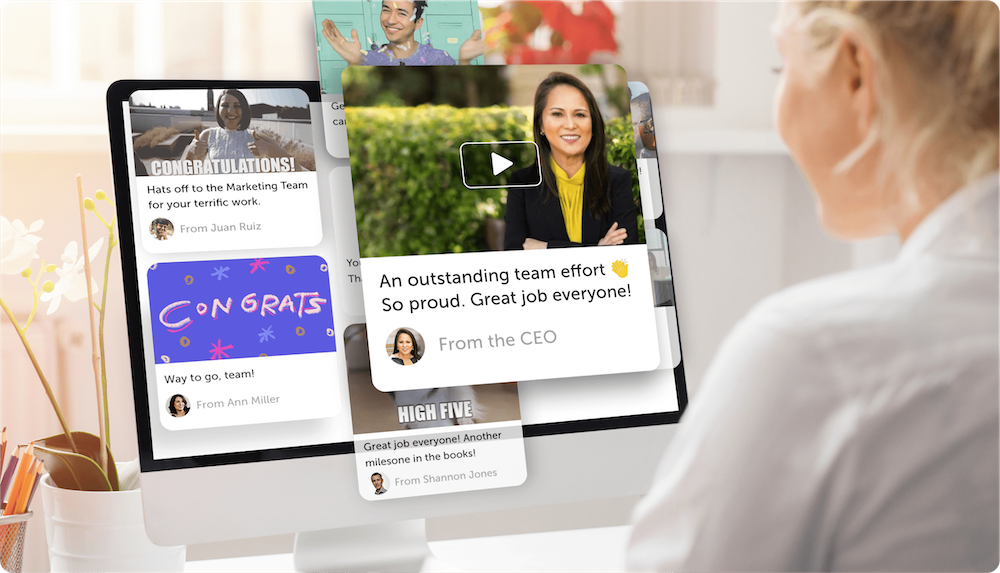Do your employees feel valued?
If your company uses a basic points system to reward employees for their contributions, the answer is probably no. After all, basic points systems don’t allow for much personalization.
In this article, we explore why personalized employee recognition is so important, companies that use personalized employee recognition tactics you can use to build something similar, how to recognize employees in a personal way with Kudoboard, and more.
The Power of Personalized Employee Recognition

Why is personalized employee recognition so important? Before we answer that question, let’s talk about what it looks like. Personalized recognition does two things:
Acknowledges Individual Contributions: Group recognition is valuable. But if you don’t recognize individual contributions, team members won’t feel like their personal efforts matter. They’ll think, “I guess anyone can do this job. Why should I go above and beyond to prove my worth?” This way of thinking leads to low employee engagement.
Accounts for Individual Preferences: Different employees want to be recognized in different ways. Imagine giving a Starbucks gift card to someone who doesn’t drink coffee. The employee will think, “Wow, my company doesn’t know me at all. Should I make sacrifices for my job?” This way of thinking leads to low employee retention.
Back to the original question: why is personalized employee recognition so important? Because it treats employees like the unique human beings they are. When this happens, they’ll work harder, perform better, and stick around for longer. Since you can’t build a successful business without hardworking, committed team members, personalized recognition is essential.
Personalize Your Employee Recognition
Ensure your employees feel the love with a tool that caters to their preferences
Companies With Top-Level Employee Recognition Programs

The best employee recognition programs are personalized. Team members don’t receive generic thank-yous or plaques. They get custom messages and employee rewards that speak to individual contributions and preferences. With that in mind, let’s look at a few companies that excel at personalized employee recognition—and how to adopt their strategies.
Airbnb: Make Employees Feel Like They Belong
Airbnb has completely changed the hospitality industry. But its founders didn’t achieve this feat on their own; they employed an elite and enormous team of professionals. You might be wondering, “How does Airbnb keep its worldwide team motivated to hit goals?” By building community within its ranks via real-time, company-wide celebrations that happen in each employee’s language. This strategy helps employees feel like they belong and their contributions matter.
How to Implement a Similar Employee Recognition Strategy: You might not employ thousands of people around the world, but you can still build a thriving work community. Recognize team and individual contributions to both reinforce company values and ensure employees feel like their work matters. Then allow your staff to do the same with peer-to-peer shoutouts. This will create a corporate environment that goes beyond “business as usual.”
Patagonia: Never Miss an Employee Milestone
Patagonia is known for its high-quality clothing and commitment to sustainability. The brand couldn’t achieve either of these things without its global team, which Patagonia engages by celebrating important milestones. Every employee birthday and “Pataversary” (a work anniversary with a Patagonia-style twist) is treated like a significant event. This seemingly small act ensures employees are appreciated for their efforts in a tangible way.
How to Implement a Similar Employee Recognition Strategy: Employee milestones are an easy way to recognize employees and thank them for their contributions. This is especially true if you use the right employee recognition platform. A tool like Kudoboard, for example, will let you send digital cards to celebrate birthdays, work anniversaries, and more. You can even automate the process so you never forget to acknowledge your team. Win!
Huron: Celebrate Your Employees Publicly
Huron, a global consulting group, was built on a people-driven culture. The company continues to thrive, in part, because it’s still committed to honoring its employees. For example, Huron always celebrates work-related holidays, such as Administrative Professionals Day, by thanking employees in public. It also uses software to foster collaboration between colleagues. This not only helps the brand achieve business goals but also improves employee happiness.
How to Implement a Similar Employee Recognition Strategy: Public appreciation can boost employee morale and establish company values, and workplace collaboration can improve job satisfaction by up to 17%. So, what if you created an online “praise” board to honor your employees’ accomplishments, then let both managers and team members post to it? This public form of employee appreciation will almost certainly improve relationships between team members, which could lead to better collaborations in the future.
Roche: Honor Departing Employees
Roche is a global healthcare company based in Switzerland. The company does many things to recognize its employees and create an inviting workplace culture, even when it comes to employee departures. Whenever an employee accepts a new job opportunity, Roche creates a public messaging board so remaining team members can bid their colleague farewell.
How to Implement a Similar Employee Recognition Strategy: Understand that employees leave organizations for a variety of reasons. Employees who leave on good terms should be celebrated for their contributions. This can be done with an employee experience platform like Kudoboard. Simply create a digital appreciation board and ask team members to post fun stories, share heartfelt sadness, and express well-wishes. The positive company culture this strategy creates will attract attention and make it easy to hire new talent in the future.
GoFundMe: Acknowledge Personal Accomplishments
GoFundMe, the world’s number one crowdfunding and fundraising platform, is big on staff recognition. So big, in fact, the company even recognizes team members’ personal achievements, such as getting married and having a baby. The goal? To support work-life balance and ensure employees know they’re valued beyond their workplace contributions.
How to Implement a Similar Employee Recognition Strategy: Your employees have lives outside of work. By acknowledging personal milestones—even the small ones, like finishing a 5k run to raise charitable donations—you’ll prove to your team that you care about them, not just the work they represent. This understanding will naturally engage and motivate employees while boosting morale. So, take an interest in your workers as people, learn about their lives, and celebrate things they’re excited about. (Even if said things don’t relate to company goals.)
Johnson & Johnson: Continually Support Your Employees
Johnson & Johnson, often stylized J&J for short, is one of the largest companies in the world. You don’t grow that big without building an effective recognition culture for employees. One thing that J&J does well is celebrate promotions for existing team members. Whenever an employee is promoted—or even changes roles due to physical relocation—J&J encourages other staff members to post words of congratulations and support to a public messaging board.
How to Implement a Similar Employee Recognition Strategy: Some companies excel at day-to-day recognition management. They send private messages, shout out employees in team meetings, and even hand out employee awards at the end of the year. These things are great and lead to higher job satisfaction. But don’t forget to support employees through internal job changes. While exciting, these events are often stressful. HR leaders can improve transition periods and support core values by simply rallying team members to celebrate career changes. Doing so will create a more positive work environment that people enjoy participating in.
American Red Cross: Accept Public Employee Recognition
The American Red Cross (ARC) is known for its disaster relief efforts around the world. In fact, the organization provides relief to someone every eight minutes, thanks to its donors’ generous donations. To keep its team in tip-top serving condition, some of the ARC chapters in the U.S. use software to shout out employee contributions. Even better, said software is open to the people helped by ARC team members, so employees receive recognition on multiple fronts.
How to Implement a Similar Employee Recognition Strategy: Employee recognition can happen in multiple ways. Obviously, your management team can acknowledge an employee’s efforts, as can his or her peers. But don’t forget about public recognition as well. Kudoboard and other employee recognition platforms can be used to field recognitions and encouragements from the people your company helps, AKA its customers.
How to Recognize Employees in a Personal Way With Kudoboard

As mentioned above, Kudoboard can be used to engage employees, facilitate a peer-to-peer recognition program, and even solicit employee feedback. Put simply, our tool is designed to improve employer-employee relations in a variety of ways. Speaking of which, here are a few ideas to help deliver personalized recognition with Kudoboard’s industry-leading tools.
Send an eCard
An eCard is a digital greeting card sent via email, social media, or a different virtual channel. They’re a fantastic way to recognize employees—and can be created in a flash with Kudoboard.
To use our platform, simply choose a professionally designed template. Then write a personalized message, attach photos, or even shoot a video in honor of a specific team member. Finally, send the result to your intended recipient.
One of the best things about eCards is that they can be used for public or private recognition. So you can easily tailor this strategy to the specific person you want to recognize.
If you send your ecard in a public fashion, you can ask other employees to contribute heartfelt messages as well. These peer-to-peer shoutouts will only improve the experience.
Attach a Gift Card
eCards are great, but what if you need a bit more oomph? Use Kudoboard to attach a gift card to the virtual card you’ve already created. You can do so in two different ways:
- Use company funds to purchase a gift card through our platform
- Enable group donations and allow employees to contribute funds
Whichever option you choose, Kudoboard will automatically pool funds and present them to the intended recipient with the eCard. Recipients will then get to choose how their funds are redeemed. For example, they can choose to receive a pre-paid Mastercard, a gift card to a specific store like Amazon or Target, or even donate the funds to top charities.
Print a Book or Poster
eCards are versatile. You can send them to in-person and remote teams with the click of a button. Or schedule them to send in the future so you don’t forget. You can also add images, videos, and monetary gifts to eCards so they hit harder and create more engaged teams.
But occasionally, your employees will want something they can hold in their hands. That’s why Kudoboard enables users to turn cards into physical books and/or posters.
Display a Digital Photo Collage
Kudoboard can also be used to create digital photo collages and/or slideshows.
Imagine: it’s Tina’s birthday. She walks into the office at 9am, same as always. But instead of a ficus in the lobby, there’s a TV screen that displays heartfelt happy birthday messages from all of Tina’s colleagues. She stops and watches the messages go by, a giant smile on her face.
Doesn’t that sound better than a deposit of reward points Tina can spend on company swag? Seriously, she already has the company-branded shirt, hoodie, and water bottle…
Digital collages and slideshows are a fun way to celebrate personal milestones, team achievements, and other significant events together. And Kudoboard makes it happen.
Enable Peer-to-Peer Recognition
According to research, peer-to-peer recognition can boost retention, as 75% of employees say giving recognition makes them want to stay at their current employer longer. Since it can cost up to 150% of annual salary to replace a team member, this impact on retention is a big deal.
Kudoboard makes it really easy to facilitate peer-to-peer praise. For example, all team members can contribute to group cards, or you can dedicate entire online messaging boards to peer shoutouts.
Track Your Recognition and Rewards Efforts for Max Impact

You should track your recognition program to determine what works and what doesn’t. Then you can use these insights to personalize your efforts and achieve better results.
Check Your Employee Recognition Platform’s Analytics
Your employee recognition platform should have an analytics dashboard. (If it doesn’t, consider using Kudoboard, which will give you detailed insights related to employee recognition.)
Here are a few metrics to track:
Participation Rate: The percentage of employees who actively use your company’s recognition software. Ideally, this number will be at or near 100%.
Recognition Given: The number of recognitions employees give each other. Said recognitions could be personalized messages, fun photos, or quick videos. Higher numbers are better, as more peer-to-peer recognition leads to better company culture.
Recognition Received: The number of recognitions each employee receives. Said recognitions could take the form of congratulatory messages, company awards, etc. High numbers will help you pinpoint top performers within your company.
Host One-On-One Meetings and Send Pulse Surveys
As a company leader, you already host one-on-one meetings with your staff. Use this time to ask team members questions and gauge individual employee sentiments. Specifically:
- Are you engaged in your work? Why or why not?
- Do you feel recognized for your contributions to this company?
- Do you enjoy your job? What can we do to increase your satisfaction?
- What do you think about our employee recognition software? Is it effective?
- Does our peer recognition platform create a more collaborative work environment?
If these questions make you and/or your employees feel uncomfortable, send an anonymous pulse survey instead. This will generate honest answers to build a better recognition program.
Evaluate Employee Performance and Productivity
Last but not least, study employee-centric metrics and KPIs. Examples include employee productivity, employee absenteeism, and employee retention rate.
How do these metrics relate to your employee recognition program? Consistent recognition engages employees in their work. And engaged employees tend to work harder, achieve higher productivity and performance levels, and stick around for longer periods of time.
If team productivity is low, turnover is high, and the staff who do stay in their jobs take a lot of time off, try to better personalize your recognition program to engage employees.
Improve the Employee Experience Today!
Personalized employee recognition software is key to success. By crafting a recognition strategy that prioritizes the individual, you’ll increase engagement, performance, and retention.
Kudoboard is a top employee recognition software because it’s intuitive and powerful. Use it to create customized eCards or group cards, photo collages, and online slideshows; give monetary rewards; and facilitate peer-to-peer recognition—all without sacrificing a month of work to learn the tool.




